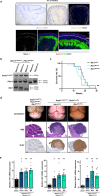Sonic hedgehog medulloblastomas are dependent on Netrin-1 for survival
- PMID: 40461501
- PMCID: PMC12134228
- DOI: 10.1038/s41467-025-59612-6
Sonic hedgehog medulloblastomas are dependent on Netrin-1 for survival
Abstract
Netrin-1 signaling is an essential prototypical neuronal guidance mechanism during embryonic development that also regulates tumor cell survival in a variety of adult cancer entities. In line with these data, a monoclonal netrin-1 blocking antibody (anti-netrin-1 mAb/NP137) has been preclinically developed and netrin-1 blockade has recently been investigated in phase 1 and 2 clinical trials in several adult cancers. Here, we investigate the role of netrin-1 in the most common malignant pediatric brain cancer, Medulloblastoma. Interestingly, we find that netrin-1 is upregulated in medulloblastoma subgroups associated with developmental dysregulation, in particular in medulloblastoma with Sonic Hedgehog (SHH) activation. First, we demonstrate that genetic deletion of netrin-1 or systemic treatment with the clinical-stage anti-netrin-1 blocking antibody significantly reduces tumor growth in vivo in various orthotopic models of SHH medulloblastomas. Second, in vitro and in vivo, we unexpectedly uncover that SHH medulloblastomas treated with an SHH-inhibitor targeting Smoothened (SMO) increase netrin-1 expression, paving the way for combinatorial therapy. In line with that, we next show that netrin-1 blockade potentiates the efficacy of SMO inhibitor therapy in vivo. Together, our data indicate that, netrin-1 blockade, used as monotherapy or in combination with SMO inhibitors, is a promising therapeutic strategy in SHH medulloblastomas.
© 2025. The Author(s).
Conflict of interest statement
Competing interests: P.M. declared to have a conflict of interest as shareholder of Netris Pharma. The remaining authors declare no competing interests.
Figures







References
-
- Guerreiro Stucklin, A. S., Ramaswamy, V., Daniels, C. & Taylor, M. D. Review of molecular classification and treatment implications of pediatric brain tumors. Curr. Opin. Pediatr.30, 3–9 (2018). - PubMed
-
- Northcott, P. A., Korshunov, A., Pfister, S. M. & Taylor, M. D. The clinical implications of medulloblastoma subgroups. Nat. Rev. Neurol.8, 340–351 (2012). - PubMed
MeSH terms
Substances
LinkOut - more resources
Full Text Sources
Molecular Biology Databases
Miscellaneous

